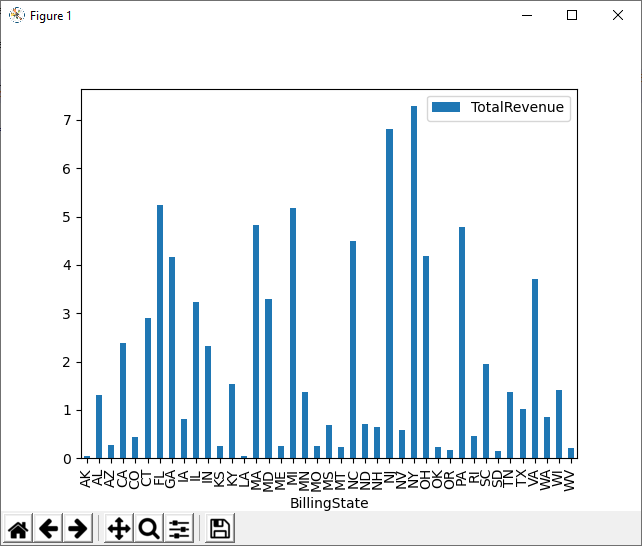Discover how a bimodal integration strategy can address the major data management challenges facing your organization today.
Get the Report →How to Visualize Adobe Commerce Data in Python with pandas
Use pandas and other modules to analyze and visualize live Adobe Commerce data in Python.
The rich ecosystem of Python modules lets you get to work quickly and integrate your systems more effectively. With the CData Python Connector for Adobe Commerce, the pandas & Matplotlib modules, and the SQLAlchemy toolkit, you can build Adobe Commerce-connected Python applications and scripts for visualizing Adobe Commerce data. This article shows how to use the pandas, SQLAlchemy, and Matplotlib built-in functions to connect to Adobe Commerce data, execute queries, and visualize the results.
With built-in optimized data processing, the CData Python Connector offers unmatched performance for interacting with live Adobe Commerce data in Python. When you issue complex SQL queries from Adobe Commerce, the driver pushes supported SQL operations, like filters and aggregations, directly to Adobe Commerce and utilizes the embedded SQL engine to process unsupported operations client-side (often SQL functions and JOIN operations).
Connecting to Adobe Commerce Data
Connecting to Adobe Commerce data looks just like connecting to any relational data source. Create a connection string using the required connection properties. For this article, you will pass the connection string as a parameter to the create_engine function.
Adobe Commerce uses the OAuth 1 authentication standard. To connect to the Adobe Commerce REST API, you will need to obtain values for the OAuthClientId, OAuthClientSecret, and CallbackURL connection properties by registering an app with your Adobe Commerce system. See the "Getting Started" section in the help documentation for a guide to obtaining the OAuth values and connecting.
You will also need to provide the URL to your Adobe Commerce system. The URL depends on whether you are using the Adobe Commerce REST API as a customer or administrator.
Customer: To use Adobe Commerce as a customer, make sure you have created a customer account in the Adobe Commerce homepage. To do so, click Account -> Register. You can then set the URL connection property to the endpoint of your Adobe Commerce system.
Administrator: To access Adobe Commerce as an administrator, set CustomAdminPath instead. This value can be obtained in the Advanced settings in the Admin menu, which can be accessed by selecting System -> Configuration -> Advanced -> Admin -> Admin Base URL.
If the Use Custom Admin Path setting on this page is set to YES, the value is inside the Custom Admin Path text box; otherwise, set the CustomAdminPath connection property to the default value, which is "admin".
Follow the procedure below to install the required modules and start accessing Adobe Commerce through Python objects.
Install Required Modules
Use the pip utility to install the pandas & Matplotlib modules and the SQLAlchemy toolkit:
pip install pandas pip install matplotlib pip install sqlalchemy
Be sure to import the module with the following:
import pandas import matplotlib.pyplot as plt from sqlalchemy import create_engine
Visualize Adobe Commerce Data in Python
You can now connect with a connection string. Use the create_engine function to create an Engine for working with Adobe Commerce data.
engine = create_engine("adobe commerce:///?OAuthClientId=MyConsumerKey&OAuthClientSecret=MyConsumerSecret&CallbackURL=http://127.0.0.1:33333&Url=https://myAdobe Commercehost.com&InitiateOAuth=GETANDREFRESH&OAuthSettingsLocation=/PATH/TO/OAuthSettings.txt")
Execute SQL to Adobe Commerce
Use the read_sql function from pandas to execute any SQL statement and store the resultset in a DataFrame.
df = pandas.read_sql("SELECT Name, Price FROM Products WHERE Style = 'High Tech'", engine)
Visualize Adobe Commerce Data
With the query results stored in a DataFrame, use the plot function to build a chart to display the Adobe Commerce data. The show method displays the chart in a new window.
df.plot(kind="bar", x="Name", y="Price") plt.show()

Free Trial & More Information
Download a free, 30-day trial of the CData Python Connector for Adobe Commerce to start building Python apps and scripts with connectivity to Adobe Commerce data. Reach out to our Support Team if you have any questions.
Full Source Code
import pandas
import matplotlib.pyplot as plt
from sqlalchemy import create_engin
engine = create_engine("adobe commerce:///?OAuthClientId=MyConsumerKey&OAuthClientSecret=MyConsumerSecret&CallbackURL=http://127.0.0.1:33333&Url=https://myAdobe Commercehost.com&InitiateOAuth=GETANDREFRESH&OAuthSettingsLocation=/PATH/TO/OAuthSettings.txt")
df = pandas.read_sql("SELECT Name, Price FROM Products WHERE Style = 'High Tech'", engine)
df.plot(kind="bar", x="Name", y="Price")
plt.show()






